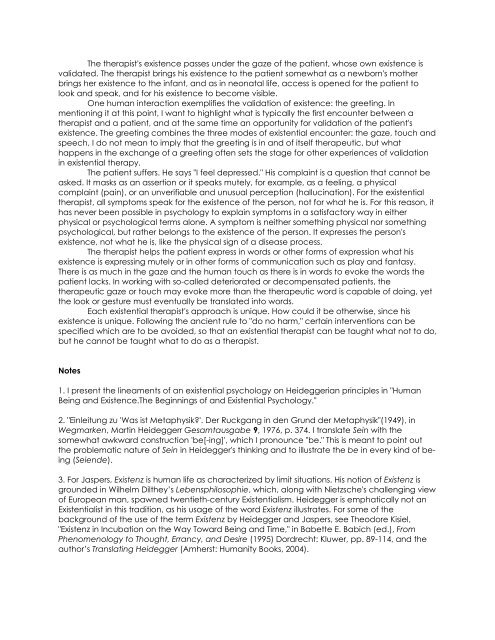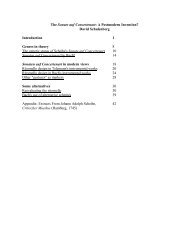SEVEN PAPERS ON EXISTENTIAL ANALYSIS ... - Wagner College
SEVEN PAPERS ON EXISTENTIAL ANALYSIS ... - Wagner College
SEVEN PAPERS ON EXISTENTIAL ANALYSIS ... - Wagner College
You also want an ePaper? Increase the reach of your titles
YUMPU automatically turns print PDFs into web optimized ePapers that Google loves.
The therapist's existence passes under the gaze of the patient, whose own existence is<br />
validated. The therapist brings his existence to the patient somewhat as a newborn's mother<br />
brings her existence to the infant, and as in neonatal life, access is opened for the patient to<br />
look and speak, and for his existence to become visible.<br />
One human interaction exemplifies the validation of existence: the greeting. In<br />
mentioning it at this point, I want to highlight what is typically the first encounter between a<br />
therapist and a patient, and at the same time an opportunity for validation of the patient's<br />
existence. The greeting combines the three modes of existential encounter: the gaze, touch and<br />
speech, I do not mean to imply that the greeting is in and of itself therapeutic, but what<br />
happens in the exchange of a greeting often sets the stage for other experiences of validation<br />
in existential therapy.<br />
The patient suffers. He says "I feel depressed." His complaint is a question that cannot be<br />
asked. It masks as an assertion or it speaks mutely, for example, as a feeling, a physical<br />
complaint (pain), or an unverifiable and unusual perception (hallucination). For the existential<br />
therapist, all symptoms speak for the existence of the person, not for what he is. For this reason, it<br />
has never been possible in psychology to explain symptoms in a satisfactory way in either<br />
physical or psychological terms alone. A symptom is neither something physical nor something<br />
psychological, but rather belongs to the existence of the person. It expresses the person's<br />
existence, not what he is, like the physical sign of a disease process.<br />
The therapist helps the patient express in words or other forms of expression what his<br />
existence is expressing mutely or in other forms of communication such as play and fantasy.<br />
There is as much in the gaze and the human touch as there is in words to evoke the words the<br />
patient lacks. In working with so-called deteriorated or decompensated patients, the<br />
therapeutic gaze or touch may evoke more than the therapeutic word is capable of doing, yet<br />
the look or gesture must eventually be translated into words.<br />
Each existential therapist's approach is unique. How could it be otherwise, since his<br />
existence is unique. Following the ancient rule to "do no harm," certain interventions can be<br />
specified which are to be avoided, so that an existential therapist can be taught what not to do,<br />
but he cannot be taught what to do as a therapist.<br />
Notes<br />
1. I present the lineaments of an existential psychology on Heideggerian principles in "Human<br />
Being and Existence.The Beginnings of and Existential Psychology."<br />
2. "Einleitung zu 'Was ist Metaphysik?'. Der Ruckgang in den Grund der Metaphysik"(1949), in<br />
Wegmarken, Martin Heideggerr Gesamtausgabe 9, 1976, p. 374. I translate Sein with the<br />
somewhat awkward construction 'be[-ing]', which I pronounce "be." This is meant to point out<br />
the problematic nature of Sein in Heidegger's thinking and to illustrate the be in every kind of being<br />
(Seiende).<br />
3. For Jaspers, Existenz is human life as characterized by limit situations. His notion of Existenz is<br />
grounded in Wilhelm Dilthey’s Lebensphilosophie, which, along with Nietzsche's challenging view<br />
of European man, spawned twentieth-century Existentialism. Heidegger is emphatically not an<br />
Existentialist in this tradition, as his usage of the word Existenz illustrates. For some of the<br />
background of the use of the term Existenz by Heidegger and Jaspers, see Theodore Kisiel,<br />
"Existenz in Incubation on the Way Toward Being and Time," in Babette E. Babich (ed.), From<br />
Phenomenology to Thought, Errancy, and Desire (1995) Dordrecht: Kluwer, pp. 89-114, and the<br />
author’s Translating Heidegger (Amherst: Humanity Books, 2004).















